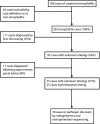Diagnostic strategy used to establish etiologies of encephalitis in a prospective cohort of patients in England
- PMID: 21865429
- PMCID: PMC3187347
- DOI: 10.1128/JCM.00862-11
Diagnostic strategy used to establish etiologies of encephalitis in a prospective cohort of patients in England
Abstract
The laboratory diagnostic strategy used to determine the etiology of encephalitis in 203 patients is reported. An etiological diagnosis was made by first-line laboratory testing for 111 (55%) patients. Subsequent testing, based on individual case reviews, resulted in 17 (8%) further diagnoses, of which 12 (71%) were immune-mediated and 5 (29%) were due to infection. Seventy-five cases were of unknown etiology. Sixteen (8%) of 203 samples were found to be associated with either N-methyl-d-aspartate receptor or voltage-gated potassium channel complex antibodies. The most common viral causes identified were herpes simplex virus (HSV) (19%) and varicella-zoster virus (5%), while the most important bacterial cause was Mycobacterium tuberculosis (5%). The diagnostic value of testing cerebrospinal fluid (CSF) for antibody was assessed using 139 samples from 99 patients, and antibody was detected in 46 samples from 37 patients. Samples collected at 14 to 28 days were more likely to be positive than samples taken 0 to 6 days postadmission. Three PCR-negative HSV cases were diagnosed by the presence of virus-specific antibody in the central nervous system (CNS). It was not possible to make an etiological diagnosis for one-third of the cases; these were therefore considered to be due to unknown causes. Delayed sampling did not contribute to these cases. Twenty percent of the patients with infections with an unknown etiology showed evidence of localized immune activation within the CNS, but no novel viral DNA or RNA sequences were found. We conclude that a good standard of clinical investigation and thorough first-line laboratory testing allows the diagnosis of most cases of infectious encephalitis; testing for CSF antibodies allows further cases to be diagnosed. It is important that testing for immune-mediated causes also be included in a diagnostic algorithm.
Figures





References
-
- Aurelius E., Johansson B., Skoldenberg B., Staland A., Forsgren M. 1991. Rapid diagnosis of herpes simplex encephalitis by nested polymerase chain reaction assay of cerebrospinal fluid. Lancet 337:189–192 - PubMed
-
- Chapman M. D., et al. 2007. Quantitative demonstration of intrathecal synthesis of high affinity immunoglobulin G in herpes simplex encephalitis using affinity-mediated immunoblotting. J. Neuroimmunol. 185:130–135 - PubMed
Publication types
MeSH terms
Substances
Grants and funding
LinkOut - more resources
Full Text Sources
Medical

